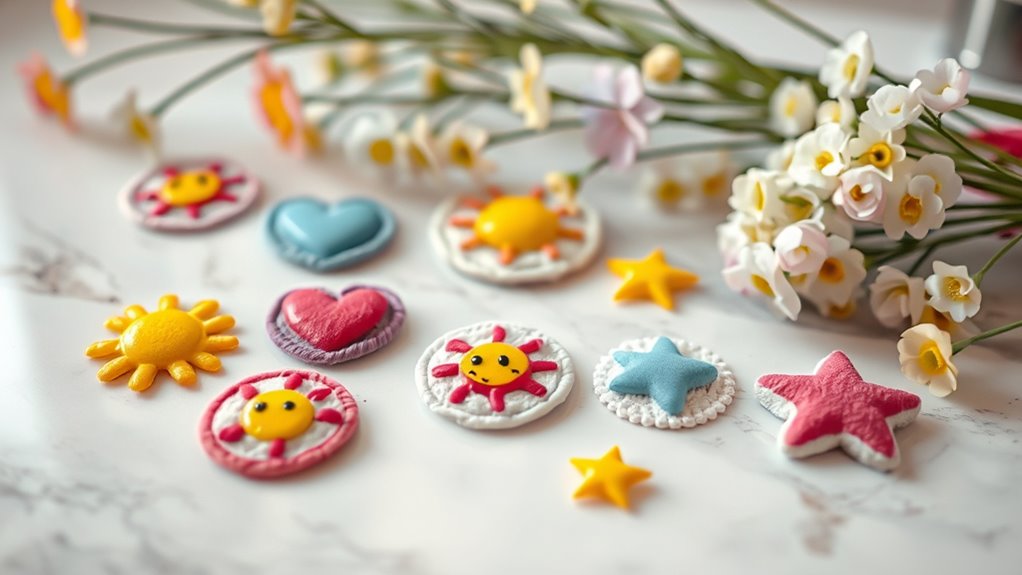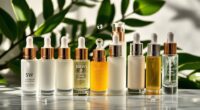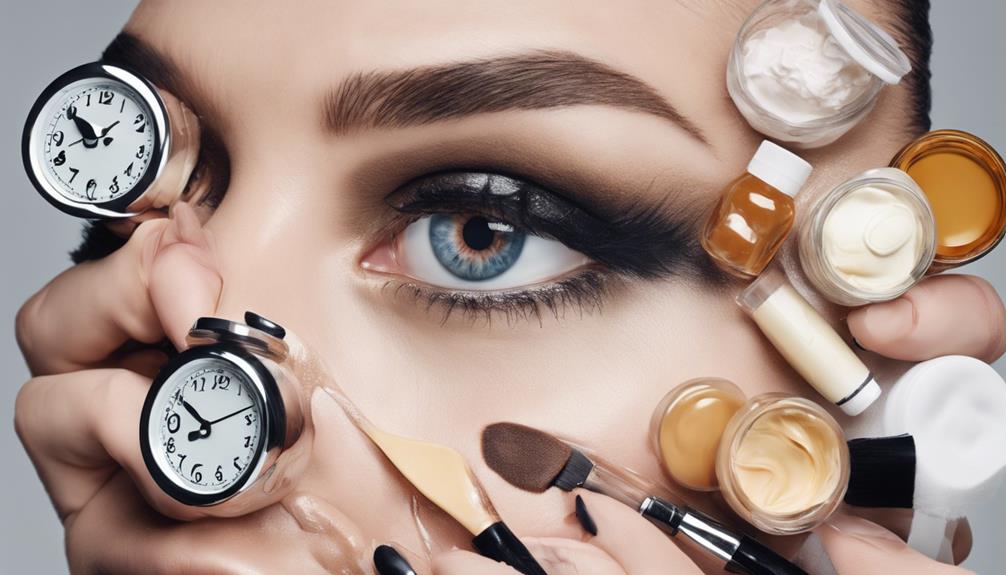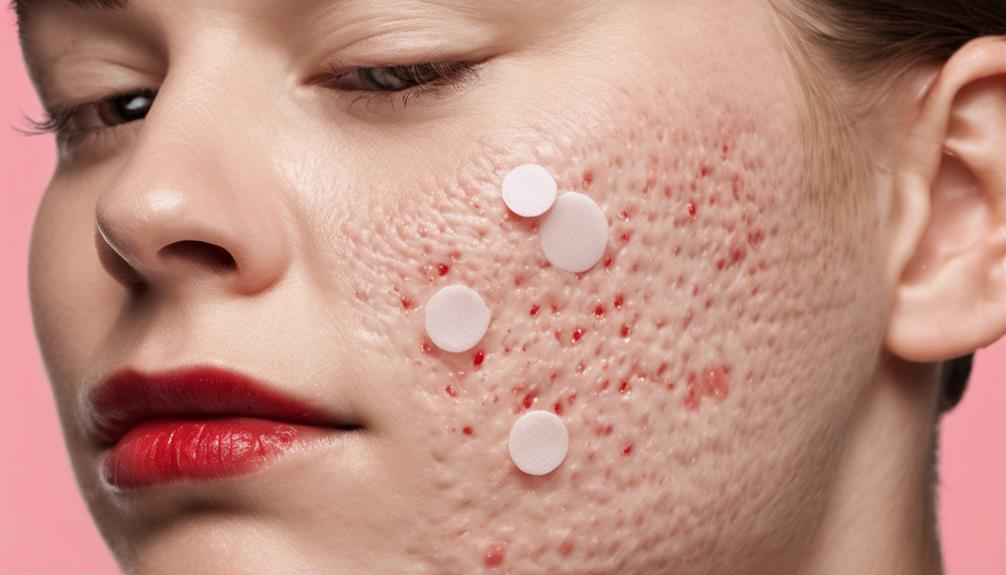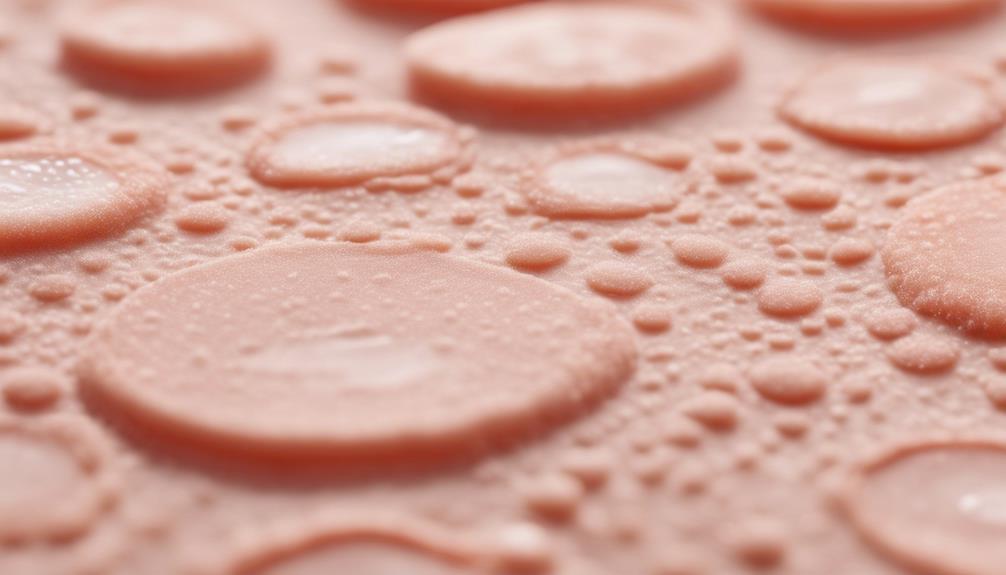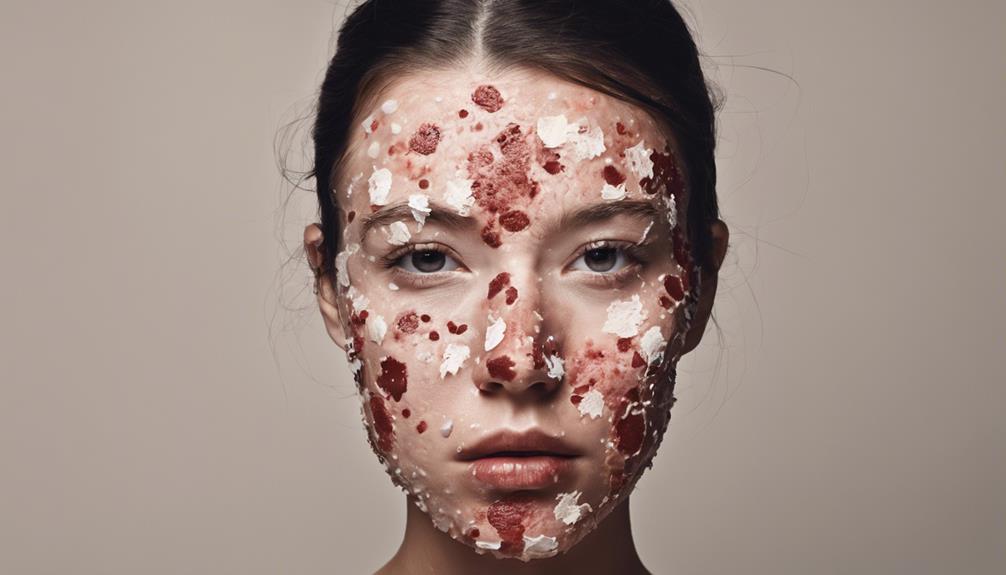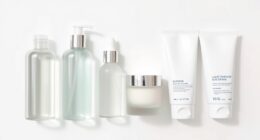These cute pimple patches are designed to effectively combat breakouts while adding a charming touch to your skincare routine. Made from hydrocolloid materials, they absorb excess fluids and create a protective barrier over your pimples. You’ll love how easy they are to use—just apply them to clean, dry skin and let them work their magic. Plus, they come in fun designs that make wearing them feel like a treat. Want to know more about their benefits and how to use them?
Key Takeaways
- Cute pimple patches come in fun designs, making acne treatment more enjoyable and stylish.
- They effectively seal off pimples while absorbing excess fluids for faster healing.
- The hydrocolloid material creates a gel-like barrier, promoting a moist environment for acne recovery.
- Medicated options contain active ingredients like salicylic acid to target inflammation and redness.
- Discreet and easy to use, these patches enhance confidence while treating breakouts.
What Are Pimple Patches?

Pimple patches are your go-to solution for treating pesky breakouts quickly and discreetly. These small adhesive stickers, often made from hydrocolloid materials, stick to your skin and blend in seamlessly. You’ll find them in clear or skin-toned options, perfect for wearing during the day or even under makeup. Medicated patches contain active ingredients like salicylic acid, while non-medicated ones focus on absorbing impurities. They work best on surface-level acne, making them ideal for small, pus-filled pimples but not for deeper cystic acne. By creating a barrier, they prevent irritation and discourage you from picking at your skin, ultimately speeding up the healing process. The unique ability of hydrocolloid patches to soak up infected fluid enhances their effectiveness for treating open pimples.
How Do Pimple Patches Work?
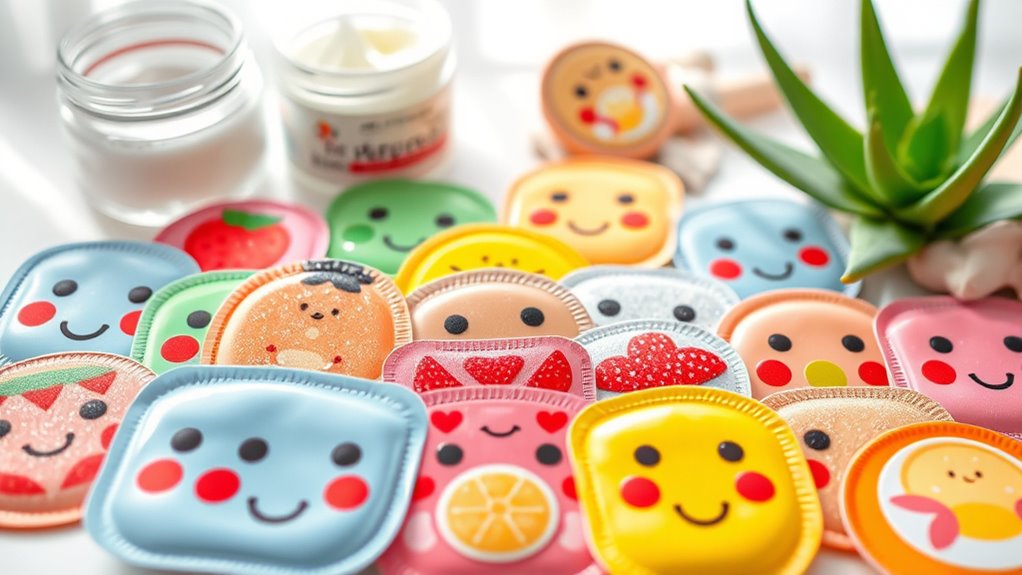
Pimple patches act like adhesive bandages, sealing off the pimple and absorbing excess fluids like oil and dirt. When the hydrocolloid material meets moisture, it forms a gel-like barrier, promoting a moist environment for healing. This barrier draws out impurities, reducing inflammation and the chance of scarring. These patches are suitable for all skin types, making them an accessible option for many individuals dealing with acne. Additionally, they are often made with hydrocolloid material, which is known for its effectiveness in moisture retention.
As they absorb moisture, you’ll see the patches turn white, indicating their effectiveness. While hydrocolloid patches are the most common, some contain active ingredients like salicylic acid, targeting deeper issues.
These patches protect the skin, prevent picking, and can reduce pimple size over days, making them a gentle yet effective option for acne management.
Who Can Use Pimple Patches?

Who can benefit from using pimple patches? If you’re between 18 and 34, you’ll likely find these patches handy for quick acne management. While women primarily use them, they’re becoming popular among all genders, so don’t hesitate to try them out. Most skin types can use pimple patches, but if you have sensitive skin, opt for hypoallergenic options. They’re great for tackling minor breakouts, making them perfect for teens and adults alike. However, if you struggle with severe or cystic acne, you might want to look for alternative treatments. Busy lifestyles also make these patches appealing, as they allow for easy and effective blemish control, fitting seamlessly into your skincare routine or makeup prep. Additionally, with a significant demand growth for pimple patches, their popularity is clearly on the rise.
Types of Ingredients Used

When dealing with breakouts, knowing the types of ingredients in pimple patches can help you choose the right one for your needs.
Salicylic acid is a popular choice, as it exfoliates, unclogs pores, and reduces inflammation. If you’re looking for antibacterial properties, tea tree oil effectively combats acne-causing bacteria. For hydration, hyaluronic acid retains moisture, balancing the drying effects of acne treatments. Niacinamide improves skin texture and tone, while retinol promotes cell turnover to reduce lesions and prevent future breakouts. Each ingredient serves a unique purpose, so understanding them can guide you in selecting the most effective patch for your skin type and concerns. Additionally, medicated patches are specifically designed for inflamed acne, helping to reduce bumps, pain, and redness.
Benefits of Using Pimple Patches

Pimple patches offer a range of benefits that can transform your skincare routine. They’re easy to apply, requiring just a clean surface and the patch itself. Plus, their transparent or skin-toned design allows for discreet wear throughout the day. You can choose from various sizes to suit different pimples, and they’re lightweight, making them portable for on-the-go touch-ups. These patches act as a protective barrier, reducing the urge to pick at blemishes, which prevents irritation and potential scarring. They also absorb excess oil and promote a moist healing environment, speeding up recovery. Additionally, wearing them can boost your confidence by concealing visible breakouts, allowing you to feel more comfortable in your skin. Pimple patches are particularly effective for treating individual, surface-level pimples, helping to reduce inflammation and enhance healing. Incorporating hydrating serums into your skincare routine can further improve skin health and aid in the recovery process. Regular use of pimple patches can also enhance the skin’s overall appearance by promoting cell turnover, which is essential for maintaining a healthy complexion.
Limitations of Pimple Patches

While pimple patches provide numerous advantages for managing minor breakouts, they do have limitations that you should consider.
First, these patches mainly target surface-level pimples and won’t penetrate deep enough to treat cystic acne effectively. If you have sensitive skin, you might experience irritation or allergic reactions to ingredients like salicylic acid. Additionally, patches offer only temporary relief and don’t address underlying acne causes, such as hormonal imbalances. They’re also single-use, contributing to waste and ongoing costs. Finally, adhesion can be an issue—especially on oily skin or in sweaty conditions—leading to decreased effectiveness. Moreover, pimple patches are typically made of hydrocolloid, which means they are more effective for blemishes that have come to a head rather than deeper acne types. For best results, consider using best pimple patches for cystic acne alongside your regular skincare routine.
Alternatives to Pimple Patches
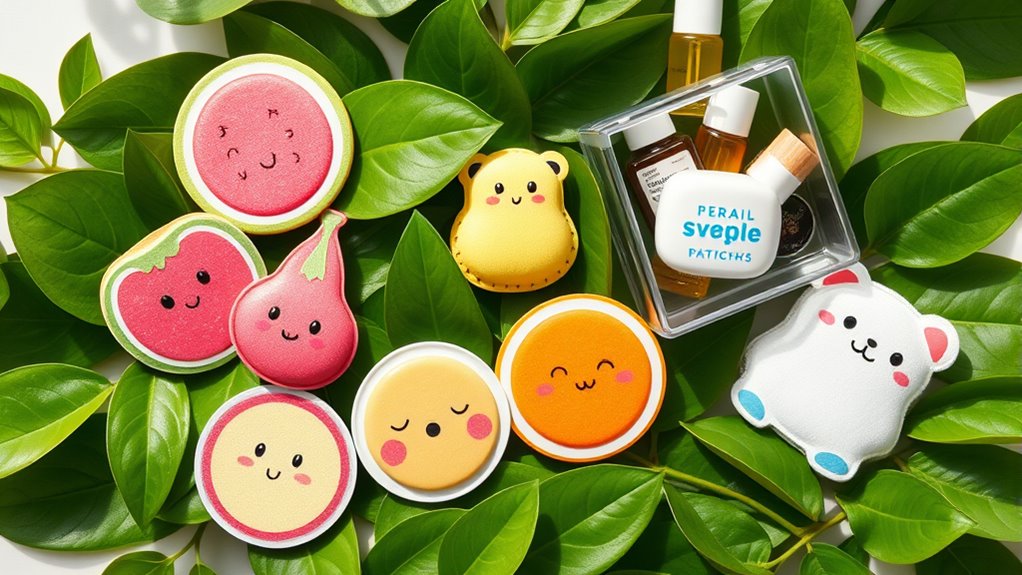
If you’re looking to tackle acne without relying solely on pimple patches, there are several cost-effective and natural alternatives worth considering. You can create DIY pimple patches using hydrocolloid bandages, cutting them into smaller pieces for a budget-friendly option. Blister paper also works well when shaped into discs. For inflammation, try soaking cotton pads in a mixture of apple cider vinegar and water. You can also rub green tea ice cubes on your skin or apply a baking soda paste to clean pores. Natural ingredients like lemon juice and tea tree oil can further help reduce acne, while high levels of antioxidants in green tea can also contribute to overall skin health. Additionally, using medical-grade hydrocolloid patches can provide a more effective barrier against bacteria and microbes, enhancing your skin’s healing process. Always remember to dilute oils significantly before applying them to your skin, especially with potent ingredients. Finally, crushed aspirin mixed with water forms a paste that may reduce inflammation, giving you more options to clear your skin.
Tips for Maximizing Pimple Patch Effectiveness

To maximize the effectiveness of pimple patches, start with a well-prepared canvas for ideal adhesion and healing. Cleanse your skin with a gentle, non-comedogenic cleanser, then pat the area dry. Avoid heavy moisturizers before applying the patch, as they can hinder adhesion. Always wash your hands before and after applying or removing patches to maintain hygiene.
Choose the right type of patch for your blemish—hydrocolloid for whiteheads, or medicated ones for inflamed spots. Consider skin type and needs when selecting the appropriate patch to ensure the best results. Apply the patch directly on the clean, dry pimple, ensuring a tight seal.
Aim to wear it overnight for best results, and consider using translucent patches during the day for discreet coverage. Finally, allow your skin some breathing time without patches to prevent irritation.
Frequently Asked Questions
Can Pimple Patches Be Used Overnight?
Yes, you can definitely use pimple patches overnight!
Applying them just before bed allows the patches to work their magic for 8-12 hours while you sleep. They absorb excess fluid, reduce inflammation, and create a protective barrier against bacteria.
Just make sure to cleanse your skin before application and moisturize afterward to keep the area hydrated.
This extended timeframe enhances their effectiveness, helping you wake up to clearer skin.
Do Pimple Patches Come in Different Sizes?
Yes, pimple patches come in different sizes to cater to various types of blemishes.
You’ll find smaller patches for tiny spots and larger ones designed for bigger pimples. This variety makes it easier for you to target specific areas effectively.
When you choose the right size, the patch adheres better and works more efficiently, absorbing fluids and promoting healing where you need it most.
How Long Should I Leave a Pimple Patch On?
You should leave a pimple patch on for about 4 to 8 hours for ideal results.
Many people find it effective to wear them overnight, extending the time to 8 to 12 hours.
If you’ve got a stubborn blemish, some patches can stay on for up to 24 hours.
Just be sure to remove the patch once it’s saturated or has absorbed the pus and debris for the best outcome.
Can I Apply Makeup Over Pimple Patches?
Yes, you can definitely apply makeup over pimple patches!
Just make sure your skin is clean and dry before putting the patches on.
Use a light touch when applying makeup to avoid displacing the patch.
Choose a matte finish concealer to blend seamlessly and lightly dust with translucent powder to set everything.
Finish with a setting spray to keep your makeup in place, and you’ll have a smooth and protected look throughout the day!
Are There Vegan Pimple Patch Options Available?
If you’re on a quest for vegan pimple patches, you’re in luck—there’s a veritable treasure trove of options!
Brands like Starface, Alba Botanica, and Mighty Patch offer effective, cruelty-free solutions that’ll make your skin feel pampered.
These patches not only absorb fluid and protect your skin but also keep it moisturized. Plus, they’re gentle enough for all skin types, so you can tackle those pesky breakouts without a worry!
Conclusion
So, you might think pimple patches are just a cute gimmick, but they really pack a punch! These adorable little helpers not only look great on your skin, but they also work wonders by absorbing impurities and reducing inflammation. Whether you’re dealing with an unexpected breakout or just want to prevent one, pimple patches are a fun and effective solution. Give them a try—you’ll be amazed at how they transform your skin while making you smile!
